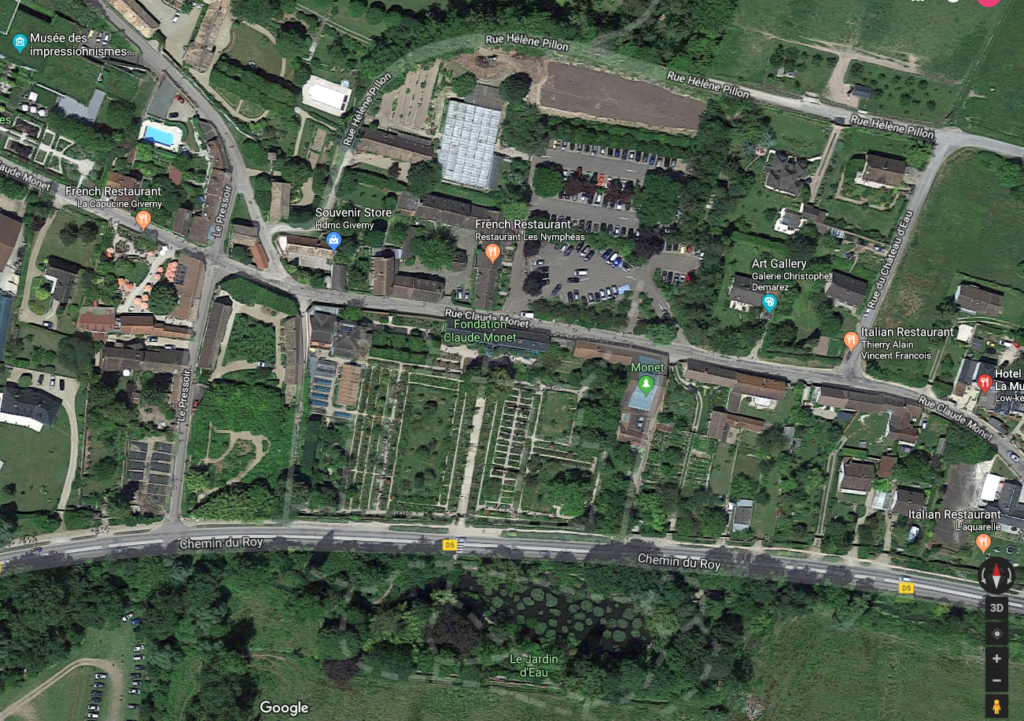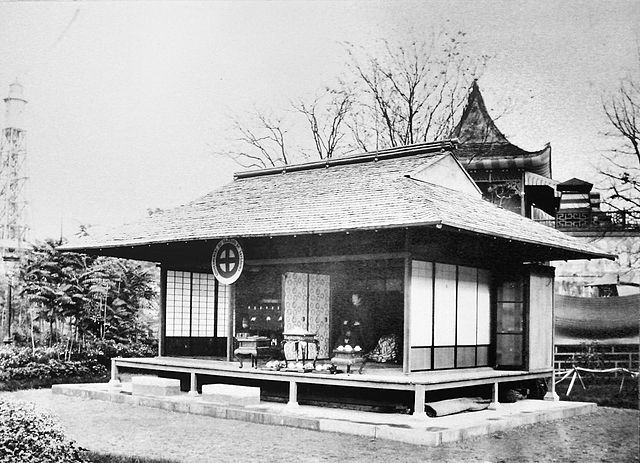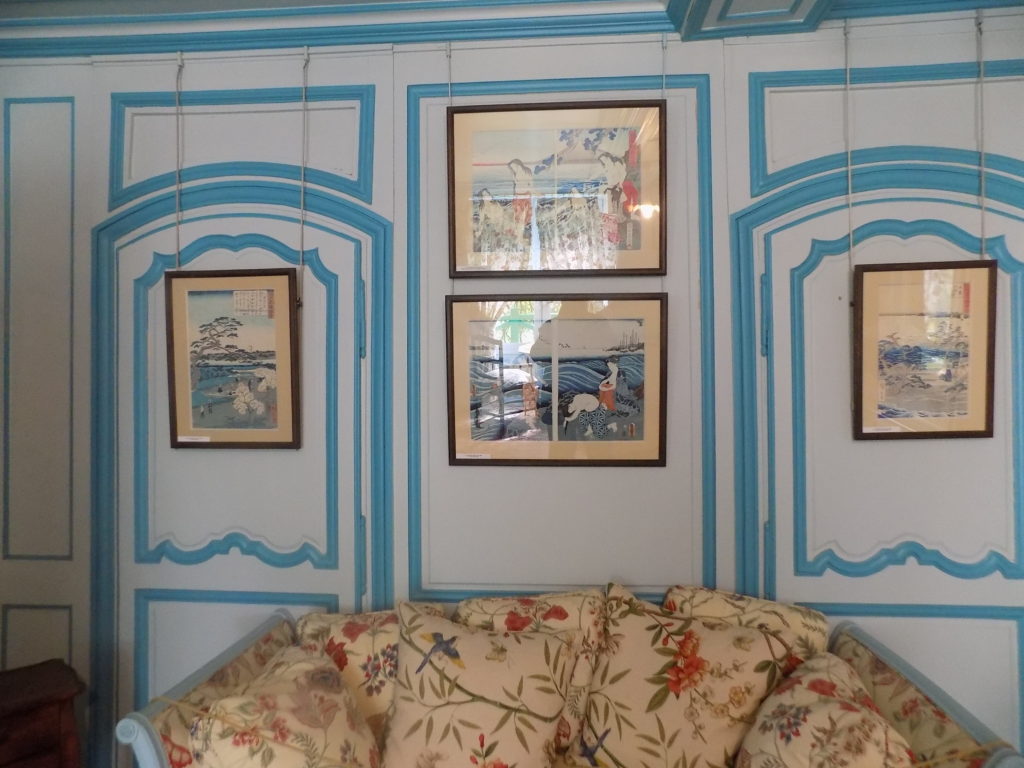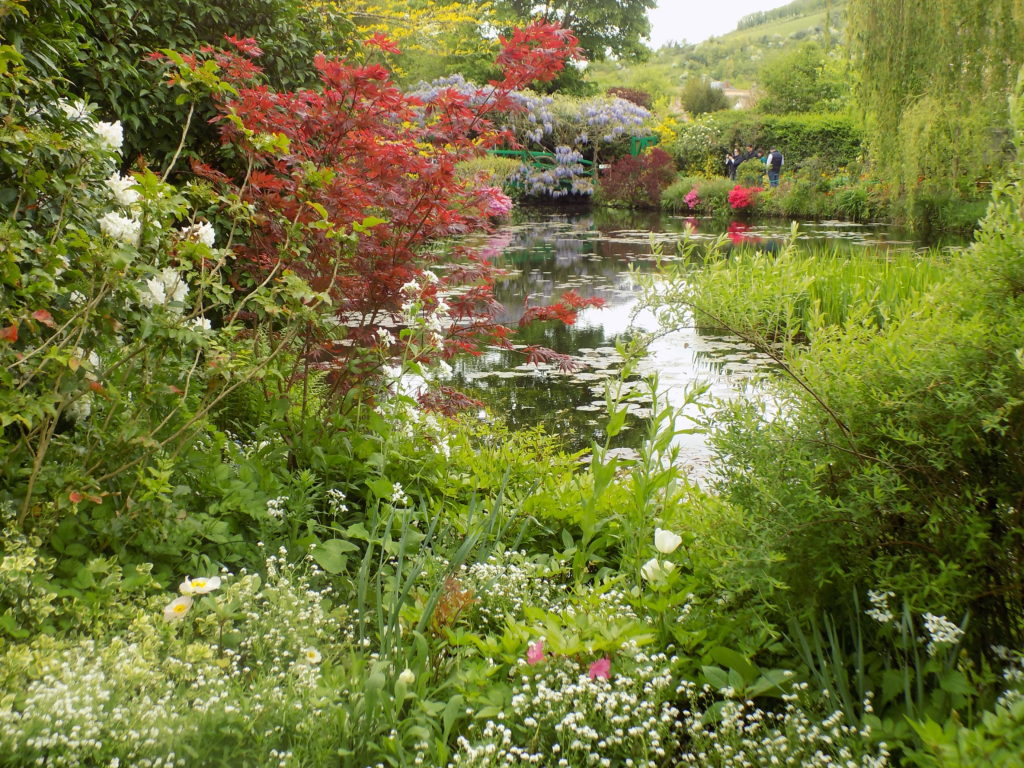House and (a not especially Japanese) Garden.
Once he purchased the house at Giverny, Monet set about renovating it. Supervising the renovation himself, he made certain that the colors of the house and its interior matched the bright colors of his palette. He chose pink for the outside and had the windows, doors, and shutters painted bright green. Like the exterior, the bright yellow dining room and the modestly more tranquil blue kitchen have been restored to their 19th century condition. We will see them shortly.
When our buses arrived, we parked on the south side of the Chemin de Roy just a bit west of the area in the satellite photo.
After a brief bit of chaos regarding our entry tickets (an aspect of the trip to which I’d become accustomed), we crossed via an underground passage into the Japanese inspired Jardin d’Eau. But before we get there, let’s take a look at some of the influences that inspired Monet to add this garden to complement the more traditional Clos Normand.
The earliest Dutch traders arrived in Japan in 1543. They opened up trade and relations with Europe until the Sakoku Edict of 1635 – a Japanese decree intended to eliminate foreign influence. By 1639, Japan had expelled all foreigners and the country remained isolated until Commodore Matthew Perry sailed into the harbor at Tokyo Bay on 8 July 1853.
By 1854, the United States had concluded the Treaty of Kanagawa which opened two Japanese ports to American trade and allowed the U S to establish a consulate in Japan. The Harris Treaty (not related in any way to the Harris Teeter) that was signed in 1858 granted additional rights to Americans and became the basis for agreements signed soon thereafter with most European nations.
From the middle of the 19th century to the beginning of the twentieth, the French loved holding World Expositions. In previous entries, I’ve made at least passing reference to the World’s Fairs of 1889 (and the erection of the Eiffel Tower) and 1900 with the construction of the Gare d’Orsay. But the French also held Expos in 1855, 1867 and 1878. The important Exposition for the current discussion was the 1867 Expo. Why? This photo (from Wikimedia) is a visual representation of the reason.
It had been less than a decade since Japan had broadly opened itself to the west and Japanese bric-Ă -brac be it silk, kimonos, lacquers, or bronzes could be found all over Europe. The French, always eager to be on the cutting edge of new fashions, adopted the trappings easily and quickly in a trend that came to be called Japonisme.
However, it was at the 1867 World’s Fair where the Parisians first saw an organized exhibition of Japanese art. The most important exposure came with the exhibition of the ukiyo-e woodcut prints. (Ukiyo is the Japanese concept of “the floating world” that developed in the Edo period from 1615-1868. The floating world was an imagined universe of wit, stylishness, and extravagance with just a hint of of naughtiness, hedonism, and transgression against social norms.) For the French, the Japanese aesthetic was novel and fascinating.
Degas and Monet are generally considered the two French painters who most absorbed and incorporated the Japanese influence. Monet amassed a significant collection of Japanese woodcuts and many that still hang in his home
evince aspects that were absent from traditional French painting but were prized by the Impressionists.
First and foremost, woodblock printing created an illusion of depth that was practically non-existent in European works of the time. Also, much of the subject matter for ukiyo-e, especially in the 18th and 19th centuries was drawn from everyday life. It celebrated the non-heroic and was based on the idea that everything is transient. More technically, it incorporated elongated pictorial formats, asymmetrical compositions, aerial perspectives, and spaces emptied of all but abstract elements of color and line. The effect of these prints is one of the factors that moved Monet to construct his Jardin d’Eau (Water Garden).
One should not view the Water Garden as a Japanese garden but instead see it as Japanese inspired. Monet’s familiarity with the work of Hiroshige and Hosukai, his acquaintance with Hayashi Tadamasa, and his participation in the “Japanese dinners” of the time likely provided much of that inspiration and motivation.
(Every element of a Japanese garden has purpose and the principal purpose is to imitate nature. A deep cultural reverence for nature stemming from ancient religious beliefs means that the ideal Japanese Garden will look like the outside world but on a smaller scale. It should inspire tranquility, awe, or both. Anything that would be found in nature can be integrated into the design.
Since most Japanese gardens are found in small, enclosed spaces their elements become symbolic. Small pools can be seen as lakes and boulders can represent mountains.
A good garden results when the designer is attuned to three essential sources of information and inspiration: the needs and desires of the persons for whom the garden is being created, the contours of the site and the surrounding landscape, and the nature of locally available materials.
Filled with internal contradictions, the garden is supposed to look natural yet each detail down to the placement of every rock is carefully considered. Even with such careful attention, it’s often said the design of a Japanese garden is never finished. Like nature, it is always changing.)
Monet filled his garden (and the pond that he created by diverting the Epte River) with both native and non-native plants. For example, he substituted Japanese crabapple and oriental cherry trees for native apple species. He imported bamboo from China and Japan and the water lilies
which would become the subject of his series of approximately 250 paintings Les Nymphéas (Water Lilies), were not only imported from Egypt and South America but were also the product of intense hybridization by the Parisian horticulturist Joseph Bory Latour-Marliac. (Local authorities, certain the imported plants would poison the water supply, demanded that Monet uproot them. He ignored them.)
As if emphasizing the notion that the garden was his creation and not meant to be truly Japanese, Monet painted his bridge green rather than red as would be a painted bridge found in a typical Japanese garden. Clearly desiring a contrast with the Clos Normand, the design of which is straight and regular, the water garden is full of asymmetries and curves. Rather than an orderly, carefully considered placement of each element, Monet’s garden looks haphazard.Â
Still, it clearly fulfilled one of the three essential informational sources – the needs and desires of the person for whom the garden was created. Monet began the process of creating the garden in 1893. He wouldn’t paint it until 1899.
I’ll have a deeper discussion of the Water Lilies when I return to Paris. For now, know that Monet began the series in a troubled time in his life. Alice died in 1911 just a year before he began painting the series. The elder of his two sons, died just three years after Alice and it was at about this time that Blanche, Alice’s daughter and Jean’s widow, began to care for the aging Claude whose vision was hampered by cataracts.
We’ll continue our look at Monet’s estate in the next post.



